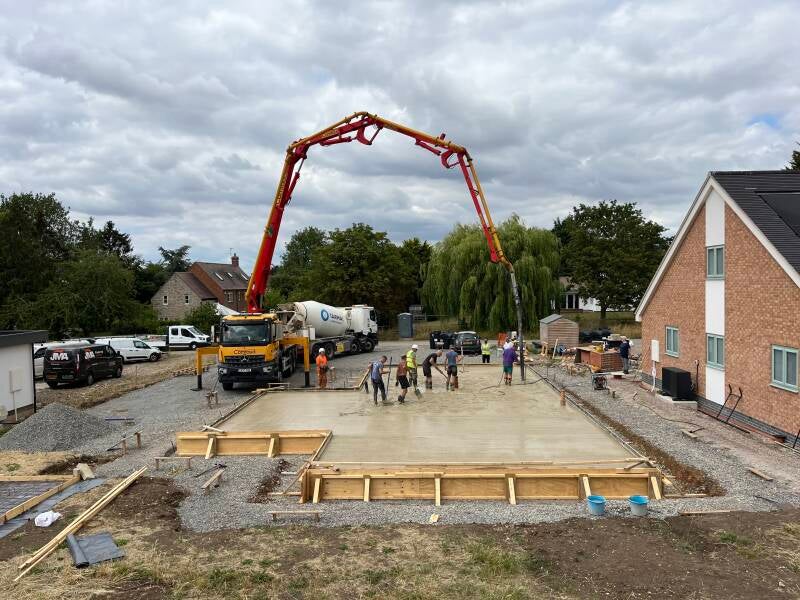
Wednesday 16th July was a big day for us - after a lot of hard work and six truck loads of eco-cement (more on that below) we are now officially "out of the ground". The day started well, no rain forecast and the temperature was ideal - around 18C at 8am. The pump lorry arrived on time and was in position to pump the cement across our foundation footprint BUT where were the trucks which were promised to arrive from 8:45?!
Hmm ... after several, increasingly forceful (irate?) calls, Tarmac promised that we would get four lorries spaced out between 11 and 12:30 - we'll over two hours later than promised, so what was the delay? ... you may have guessed it ... HS2. When HS2 ask for cement Tarmac apparently says "of course, we will be right on it and you can jump the queue made up of other smaller customers". I guess with our precious 45 cubic metres of concrete we didn't have much bargaining power. However, paying for eight people to stand around doing nothing for over two hours (two person days of work!) isn't the way you want to spend your budget.
Fortunately from 11:05, when the first truck arrived, things ran smoothly with the last truck leaving at 1:30.



Ten people were involved in the pouring of the slab including: the cement truck driver, the cement pump operator, a structural engineer and seven grafters skilfully spreading and levelling the concrete across the footprint of our future footprint. Time was at a premium and the work intense as we had 6 x 7.5 cubic metre truck loads, arriving at intervals of approximately 30 minutes. The critical factor leading to our success was that everyone mucked in with the more experienced guys directing the less experienced - including myself.
Building our foundations was a bit of an eye opener, not least the amount of material which has gone into them. The particular system we used is called a Raft foundation (see this link for a helpful intro into the different types of foundation - https://www.self-build.co.uk/groundworks-foundations/).
The particular advantage of a raft is it holds together as a single unit and therefore acts as a stable base which evenly spreads the load across the foundations.
We are building on heavy clay soils and a raft can help deal with heave and shrinkage. The raft also gives us a nice base for our layer of sub-floor insulation.
The raft is constructed from re-enforced concrete ie concrete with a cage of steel rods within in it. This sits on top of a damp proof membrane which is on top of compacted "Type 1" stone.
The centre of the raft is 225mm thick but has a so-called "toe" ie 250mm extra concrete around the outside edge to add further stability. The stone layer is 300mm deep.

Our environmental credentials
Building a house takes energy and materials both of which have a carbon footprint. This type of carbon is called "embodied carbon", which is different to the carbon footprint of running the house. Our aim will be to generate excess solar energy over the year ie our annual carbon footprint will be negative and will hopefully clear our embodied carbon footprint over a number (to be estimated at some point) of years.
In an update to this blog we will put figures against the embodied carbon for our foundations. Below is an initial list of contributing factors:
| Factor | Carbon Footprint kg CO2e | Comment |
|---|---|---|
| Stone | - | Clean Type 1 * |
| Steelwork | - | |
| Concrete | 4,885 | Tarmac CEVO A+ rated ** |
| Miscellaneous | - | eg Transport |
Notes:
* Figures based on Circular Economy's Inventory of Carbon & Energy (ICE) database.
** The concrete used was CEVO supplied by Tarmac from a local cement factory (15 miles away). 4.9 tonnes of CO2e is 68% of the CO2e consumption emissions for a UK Citizen (7.2 tonnes) in 2023 according to Our World in Data https://ourworldindata.org/grapher/consumption-co2-per-capita?mapSelect=~GBR By using CEVO we saved 47% embodied carbon emissions ie. 4.3 tonnes of CO2e. See this certificate for more detail:
Add comment
Comments